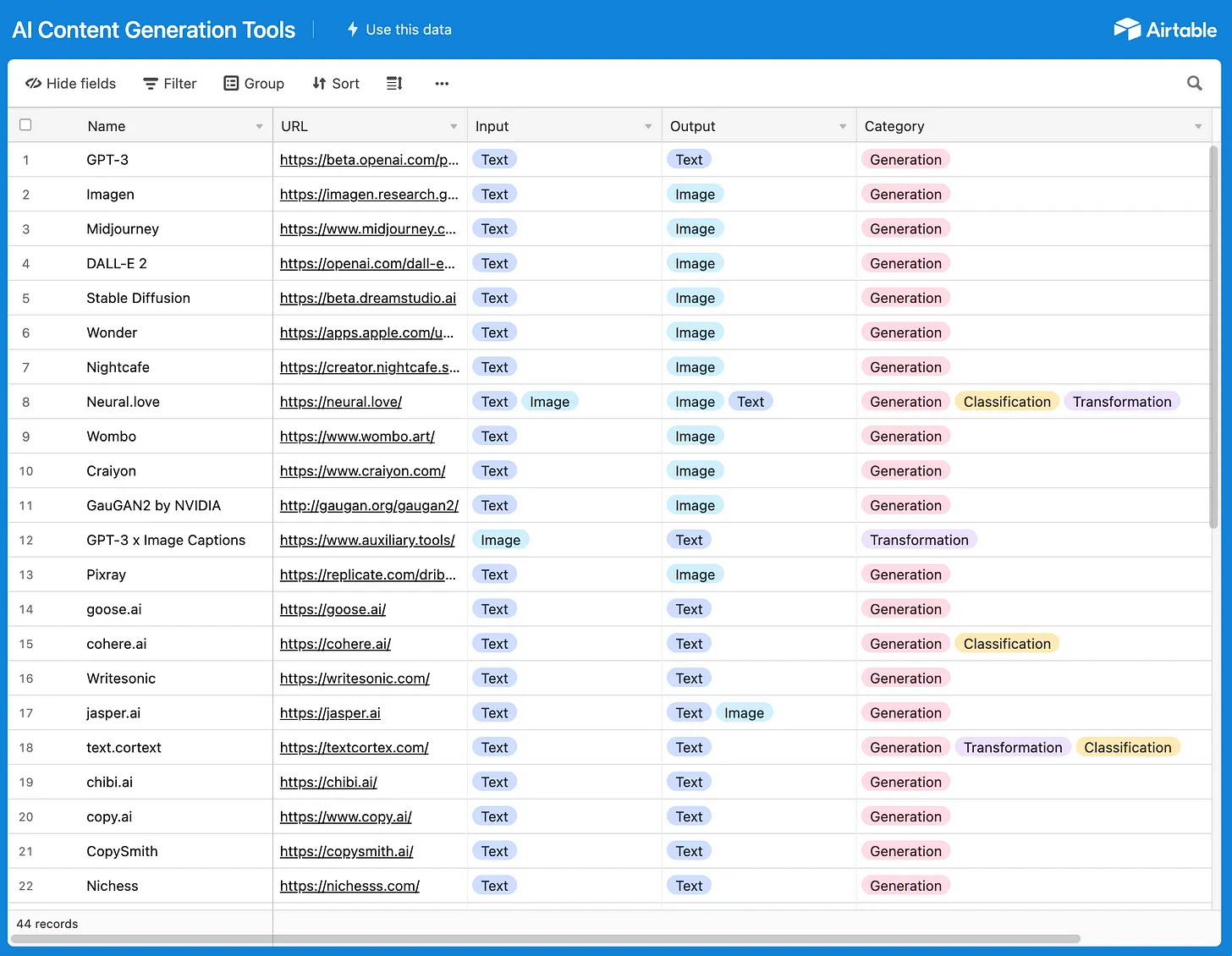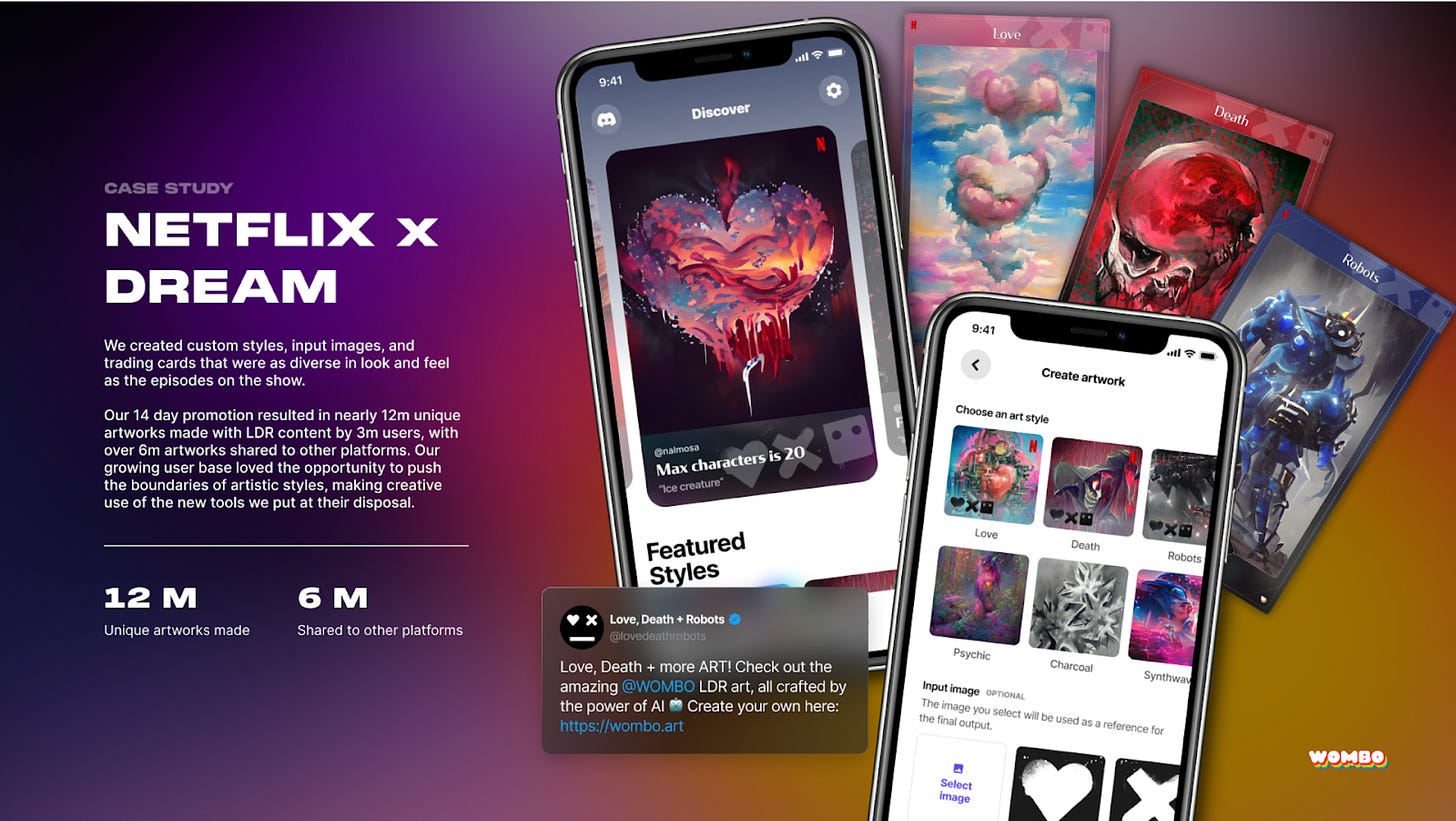Radical New World of Generative Advertising
Generative AI is taking off at a time when digital advertising is searching for a new paradigm
The growth of the digital economy has been built off innovation in advertising. Facebook and Google rose to dominate much of the market through changing the way advertising worked, decreasing costs while increasing precision. This led to better returns for marketers and hundreds of billions in economic value. While global ad spend continues to grow it has become increasing dominated by digital segments. The status quo, however, is increasingly being challenged, opening up the opportunity for a business model innovation in digital advertising to remake online dominance.
The confluence of several inflection points from Apple’s ATT challenging Facebook’s traditional third-party data driven ad model, to the changing dynamics of Search eating into Google’s margins, to the rise of Generative AI as an accessible and performant technology, all open the door for a new world of digital advertising, one that may be orders of magnitude more valuable than anything that came before.
Generative AIs have already proven their capacity to produce, remix, and personalize text, images, video, and audio which make up most advertising materials in existence. This approach can enable new forms of advertising that are less invasive of a user’s privacy, relying more on context than precision targeting, all while reducing costs. At every step of the marketing funnel, from creation to targeting to evaluation, and for both direct response and brand advertising, Generative AI promises a revolution in how digital advertising functions.

The Past and Present of Generative Advertising
Even in its infancy, Generative Advertising has demonstrated massive potential in brand advertising. Lays launched Messi Messages in March 2021, leveraging deepfake technology to personalize greetings from Lionel Messi, garnering 38 million hits in the first 24 hours. In October 2021, Bulgari leveraged AI-image generation to create a massive art installation for their Serpenti line. These spectacle driven brand campaigns were only the beginning of a movement towards personalization that has accelerated in 2022.
Jasper.ai which rebranded from Jarvis in January 2022 has quickly grown to a staple in AdTech, with their 70,000 customers using their GPT-3 powered product to write blog posts, SEO, and headlines for promotional materials.
In May 2022, Netflix leveraged Dream by WOMBO to promote the launch of Love, Death + Robots Season 3. Over a 2-week campaign, Dream users were shown input images of the logos of LDR and encouraged to make customized renditions, resulting in 12 million images produced by 2 million users. The scale and speed of this content production could not have been feasibly done by an in-house team, and by engaging a large and diverse userbase, the brand recognition of the show increased. Heinz launched a similar campaign in August, using Dall-E 2 to draw ketchup alongside human submissions.
These existing campaigns highlight the flexibility of Generative AI, allowing a scale and diversity of content production that was previously only accessible with 7-figure budgets.
The Post-ATT Landscape
As the costs of using generative techniques decrease and their quality improves, we can expect wider adoption among SMEs that rely on digital advertising for their growth, and whose cumulative marketing budgets are the key source of revenue for digital platforms.
In a pre-ATT world, smaller firms typically invested a fixed amount in producing limited creatives, spending most of their budget on targeting their ads. As the returns to targeting decrease with less tracking across the internet, an opportunity has arisen in increasing produced creatives.
A new world of contextual advertising has opened up thanks to AI, which relies more on what’s being viewed than the person viewing it. Thanks to the improving quality of AI interpretation of text, images, video, and audio, it has become easier to understand the sentiment and nature of the web page or mobile screen a user is viewing. Leveraging generative techniques, ad content can then be adjusted in response to the surrounding context, increasing conversion likelihood. For example, text generators can be used to customize ad copy to match the sentiment and phrasing of the text surrounding it, while image generators can be used to customize the color tone or background imagery to be more subtly reflective of what’s being viewed.
Rather than the creepiness factor of feeling followed across websites, contextual generative advertising can make advertising more organic to each page, allowing ads to blend more neatly into the world around them. This form of advertising can be validated through both the first-party cohort data and by using analytics on the performance of different creative customizations to create a flywheel that places ideal advertising across the web.
The opportunity created by this is enormous. In moving budgets away from precision targeting, with its naturally decrease marginal returns, and towards creative production, which was always more expensive, advertisers will have an ever-increasing opportunity to increase conversion rates. As conversions increase, so does the return to advertising, and the budgets spent on marketing, expanding the opportunity for Generative Advertising producers to profit.
Given that the nature of this production differs from the tracking abilities that Facebook/Meta products excel at, we can see Generative Advertising as a new category of competition in which traditional players do not necessarily have an advantage. The nature of the analytical flywheel has not been fully developed, so as the value of historic third-party data decreases post-ATT, companies with a generative advantage can enter the field and challenge incumbents.
New Search Advertising
The economics of search advertising are also increasingly becoming anyone’s game. As product searches increasingly begin on Amazon, and voice search increasingly emphasizes returning single results rather than lists, the traditional Google developed search advertising model no longer has the moat it once did. A user’s desire when putting in a search is not to select among possible options, but rather to receive precisely what they asked for, and Generative AI makes this a realizable possibility.
The nature of Generative AI is essentially search. Rather than searching for the best result from a limited set of possibilities, however, generative search returns the best result after combing through the entire space of possible results. If it can’t be found from what exists, it can be created anew from the learnings of the algorithm.
This search nature of Generative AI, combined with the contextual character of the post-ATT landscape, enables a new search business model that is more natively integrated across the web, rather than a destination unto itself. For example, as I write this I want to think of a witty joke, and before me are some articles that I’m using for research. If I search for an interesting joke based on what I’m reading, it would be a much more beneficial experience for me if the search engine considered the context of what I’m looking at and returned the best result it finds, and if it can’t find a great result, it should make one for me from scratch!
This combination of the analytical components of AI to understand context, and the generative components to create where existing search lacks, can supercharge the user experience. The economics of search have proven extremely lucrative, and to create a new search model that improves retention and engagement opens a radically large opportunity to remake search advertising business models.
Brands of 1
The nature of digital communities has also changed the way brand advertising affects consumers. Rather than being limited to being generically appealing to everyone like McDonalds or zeroing in on a specific niche like a Hot Topic, the segmented nature of internet subcultures has allowed brands to create more than one identity depending on the niche.
An example of this is White Claw, which managed to break free from the gendered nature of alcohol branding, not by identifying itself as a generic appealing drink, but rather by customizing its brand messaging depending on where its creatives were seen. Numerous subcultures came to identify White Claws as their drink of choice rather than an inoffensive pleaser to all or associated with a specific circumstance.
Much of this has been enabled by the analytical AI engines that customize a user’s online experience to what is most appealing to them. Often users won’t even know of the existence of another subculture let alone experience the cultural lingo that exists there. Brand advertising has tapped into this and allowed cultural presentations to adapt to the grammar of different groups.
Generative AI opens another dimension to this trend. As more content becomes AI generated the nicheness of subcultures can increase. If the content I see is more customized to exactly what I like, it may in fact result in me being the only person who ever sees it. It’s not that it didn’t find its audience, but rather that for that piece of content, I am the extent of the intended audience.
The degree to which brands can then customize their identity to different niches vastly increases with Generative AI, and as I grow to have a feeling that a brand is specifically catering to me, my engagement with them would likely increase, and I would be a more retentive customer.
Advances such as DreamBooth, which can feed an individual into an AI and put them in the creatives also can increase the degree to which advertising can be built for an audience of 1, rather than a generic creative targeted to an individual. The new branding possibilities enabled by generative ai can help top of the funnel advertisers in ways that a purely tracking/targeting based approach never could.

Conclusion
Seeing the broader trends in advertising that coincide with the rise of Generative AI highlights the multiple inflection points which can make Generative Advertising a sticky new paradigm. Transitioning away from a world where users constantly feel watched by Big Tech firms has brought anxiety for advertisers, but a new mode of scaling up content production and interpreting context may in fact prove to be more valuable than what came before.
Generative AI companies that have already started to penetrate the public consciousness can build reliable moats in the type of data that can power Generative Advertising. Having produced billions of outputs for users and receiving feedback on what is well liked gives these young firms an analytical edge in understanding the appeal of creatives, which is a distinct dataset from personal data that characterized Facebook and Google’s dominance. At this early stage, capturing the Generative Advertising market remains anyone’s game, and the economic value is enormous.






Some great points. Thanks for this article. I’ve been in creative automation for brands for a number of years.
I will say that - aside from the types of “wow isn’t this AI stuff neat!?” type of campaigns you mention - the capabilities are already FAR ahead of where a lot of brands have been willing to test.
The idea of contextually adapting creative to align with content has been around in the form of Dynamic Creative Optimization for a number of years - dynamically inserting contextually relevant copy, images or CTA via macros into an ad based on pre-defined rules - but brands have been slow to adopt it and reluctant to hand over real decisioning to the algos even when we have had that capability for years.
I remember presenting an ambitious DCO campaign that would leave limited decisioning to the machine to a well known US automotive manufacturer a few years back. The CMO immediately shot it down and opted for a narrowly defined rule set because “What if the machine creates something that isn’t ‘brand safe’? We can’t take that risk.” Mind you this was just remixing existing creative elements in a database that the brand had already approved!
As you point out a lot of the early adoption will be among SMBs and performance marketers who don’t have limitless creative budgets. It’s going to be a fun industry!
This is the best post I've read on the topic – very forward thinking!
I'm coming at generative advertising from the opposite angle: generative AI services that want to monetize through ads have a problem: when you don't know what your users will generate, neither do advertisers. This breaks targeting and threatens a brand safety nightmare.
You actually need something much more like search ads on generative AI sites – but Google doesn't have a 3rd party search-display ad product.
Not every AI product can use SaaS pricing to cover their GPU costs. A bunch of generative companies are about to realize advertising is broken for them.